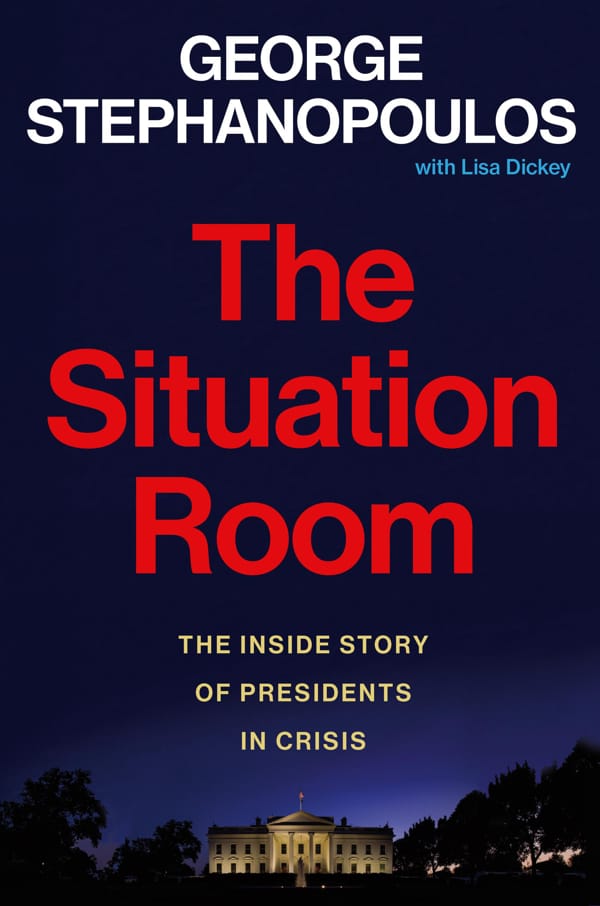Book Review: The Situation Room, by George Stephanopoulos with Lisa Dickey (Hachette, 2024)
The most famous photo to capture tension in the White House situation room shows Barack Obama and his national security team anxiously watching the 2011 raid that killed al-Qaeda leader Osama bin Laden. Less well known is the reason that the president and this group of top officials are so crammed in: they weren’t supposed to be there.
The plan was to gather in a larger room in the White House Situation Room (WHSR or Sit Room – actually a complex of rooms) where they would be updated by CIA Director Leon Panetta, via secure video teleconference (SVTC), from his command post in Langley. The operation was, mostly for legal reasons, technically led by the CIA. Panetta, in turn, was briefed by the Special Operations Commander, William McRaven, from Jalalabad, Afghanistan. McRaven was watching a live feed from the US Navy Seal operation in Pakistan. But once Obama realised that the live feed was also being transmitted to a small side room in the White House, he headed there, instantly collapsing the administrative hierarchy assembled to manage the flow of information.
George Stephanopoulos and Lisa Dickey’s enjoyably breezy history of the White House Situation Room shows how providing leaders with the best possible information is harder than you might expect, even for the world’s most capable national security bureaucracy. Ensuring that the president has only the most relevant and recent information – not too much and not too little – is a constant balancing act. The challenges range from perennially complex to surprisingly mundane. Advances in technology solve some problems while creating new ones. Personal factors matter ever more the closer you get to the apex of power.

The Sit Room has evolved in fits and starts. It was spurred forward by major failures, beginning with the CIA’s botched 1961 “Bay of Pigs” attempt to invade Cuba. Kennedy was furious about shoddy information he received both before and during the operation. Similar frustration in the aftermath of the 9/11 attacks in 2001 prompted another major overhaul.
But it was only in 2023 that the Sit Room began to look anything like it does in the movies. Yet for all the new technology, the current design is still shaped by basic human factors. Rooms sizes vary because “there are times when the president doesn’t want a full room … and White House rule number one is, if there is an empty seat, it will be filled.”
For a long time, the Sit Room was a “cramped, low-ceilinged, semi-analog series of rooms” staffed by only a single CIA officer working a 24-hour shift. Progress was held back by, among other things, successive administrations’ reluctance to start renovations that would only benefit their successors.
Presidential preferences vary greatly. Some never set foot in the Sit Room while others were regular features. Lyndon Johnson was a heavy user, though the book argues that LBJ’s obsession with minutiae didn’t make him a better decision maker. Richard Nixon went to the other extreme because, according to Henry Kissinger, Nixon was convinced that LBJ had suffered from “Situation Room syndrome” (though Kissinger’s own obsessive control information flow to the president probably also explains that).

The original designers clearly intended the Sit Room to be an information clearing house rather than a command post. But during crises it inevitably became a decision-making venue. Unhappy with how it functioned after the attempted assassination of Ronald Reagan in 1981, National Security Advisor John Poindexter decided to create a separate Crisis Management Centre (CMC) in the White House. Combined with newly-invented email services, this effectively bypassed the rest of the national security bureaucracy and enabled Colonel Oliver North to illegally sell arms to Iran in 1986 and to funnel the proceeds to the Nicaraguan contras. The CMC was shut down.
Over time the Sit Room has also become the locus for direct communication between the White House and other governments.
A hotline to Moscow was established after the Cuban missile crisis. In its absence, Nikita Khruschev had found that the best way to tell Washington he was pulling missiles out of Cuba was to announce it on Radio Moscow. But when the line first became hot, in the 1967 Arab-Israeli war, Secretary of Defence Robert McNamara was surprised to discover that it was located in the Pentagon rather than the White House. An extension had been installed by the time of the 1973 Arab-Israeli war, but, because it was still a teletype machine, neither side was aware that both Nixon and Soviet General Secretary Leonid Brezhnev were out of action, incapacitated by alcohol and sleeping pills. Mutual fear that the other side was exploiting the situation fuelled brinkmanship. Kissinger moved US forces to DefCon III without presidential authorisation.
Such mistakes are presumably less likely now because there are 25 SVTC lines between the White House and other governments, both friends and foes.
Scholars will never tire of debating the influence of agency and structure in international relations. This is not an academic book: the device never gets in the way of telling a good story. But books like this – and even more so David Priess’s masterful history of the President’s daily brief – illuminate the role of human agency and an array of less obvious factors in foreign policy decision-making.

